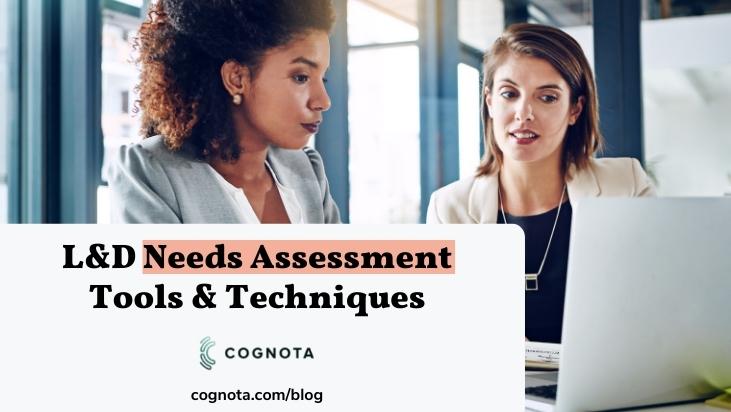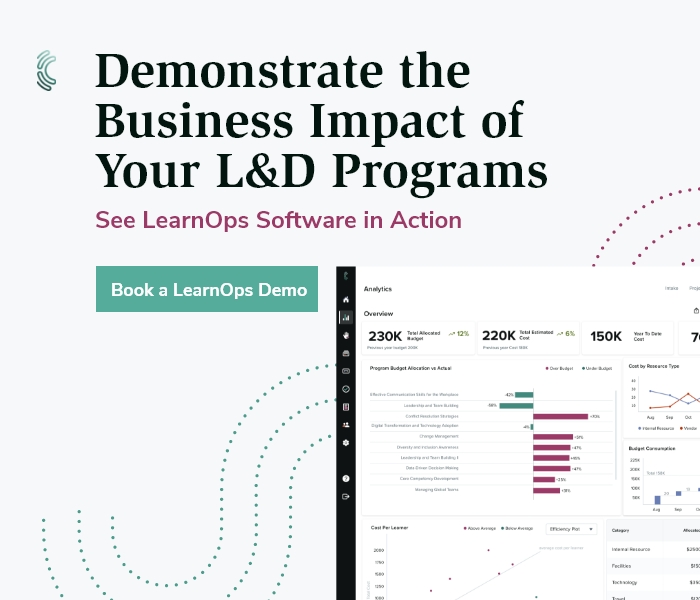Learning and development professionals use tools and techniques to help them identify the skill and knowledge gaps in their organizations. Many training needs assessment techniques still rely on tried-and-true methods such as questionnaires, focus groups, job mapping and interviews.
However, increasing numbers of needs assessment tools for corporate training are now based on technology that increases productivity and adaptability while providing form templates for virtually any aspect of training needs assessment–from a template for an employee training request form to one that records learner progress.
Getting the most out of your training needs assessment means investigating and comparing some of the best technology-based learning needs assessment tools available and the techniques that support them.
Training needs assessment process
The specifics of the training needs assessment process in your organization are unique to your company. However, solid needs assessment utilizes:
- Existing quantifiable data. Employee performance records, production statistics, hours worked, accuracy reports, and customer feedback all provide the foundation for assessing training needs.
- Formal testing. Performance tests and personality tests provide objective data about each employee’s training and knowledge gaps.
- An employee’s self-assessment. This assessment allows the employees to identify their own strengths, weaknesses, goals, and accomplishments. While not as objective as other sources of information, self-assessments reveal much about motivation and personality.
- Third-party assessments from managers, vendors or co-workers. These assessments provide qualitative data that is less subjective than self-assessment and fill in a lot of detail about significant aspects of an employee’s work habits and abilities.
Comparing self-assessments and third-party assessments with formal testing results bolstered by existing quantifiable data provides a solid framework for needs assessment.
Technology-based training needs assessment tools
Before you review the list of tools, here are some important criteria to note about each entry:
- All of these needs assessment tools for training are found online.
- Any tools or templates found as part of Google or any of the Microsoft Office programs such as Word or Excel installed on your computer have been excluded.
- A few–like DiscoverLink Talent LMS and HSI–are specialty tools that serve particular niches.
Here are a dozen current needs assessment tools designed to help L&D teams deliver training that’s cost efficient and effective:
1. Cognota
Cognota is the first operations platform created specifically for L&D teams. A key feature of the platform is Training Intake. This provides a single portal through which learning and development can receive, assess, and prioritize requests for training.
Using out-of-the-box templates or by creating custom training request forms, L&D teams can leverage the Training Intake feature to gather critical information and perform an initial assessment on:
- The importance of the requested initiative in relation to corporate objectives
- What resources will be required to fulfill the training request
- Where the request falls in terms of priority in the overall training request/project queue
Users can also leverage auto-generated insights on their training intake data for needs assessment activities including where demand for training is coming from in the organization, the priority level of requests, and project completion rate.
You can check out Cognota for yourself by starting a free trial or speaking with the sales team.
2. EHS Insight
EHS Insight helps you automate your Training Management Program by providing a framework for training requests, skill assessments, and certifications. The needs assessment portion of the application helps customers meet compliance and safety requirements while reducing time and budget expenditures. EHS Insight also has templates for needs assessment techniques such as surveys, job mapping, interviews and focus groups.
EHS is robust enough to handle the requirements of global companies with thousands of users, yet also works well for small or medium-sized companies. An updated interface makes EHS more user-friendly for 2022, something that was noted as a weakness in earlier versions.
3. 360 Learning
360Learning is an LMS for collaborative learning with a special focus on upskilling and training in order to identify and extract the potential your employees represent. As such, 360Learning is particularly attractive to companies that want an easy-to-use system that helps them foster a culture of collaborative learning.
360 Learning compares the status quo with corporate goals about onboarding, upskilling and training to assess where L&D needs lie, and how they can be managed. This leads to L&D efficiency and empowers employees so that they are empowered to perform at their best and prepared for advancement within the organization.
4. TalentLMS
TalentLMS offers features that allow you to customize your training programs so that they “fit” your employees and teams well and produce the results you need. The adaptive TalentLMS software is particularly well-suited to teams.
Assessment capabilities include Assignments, Test Builder, Survey Builder and Question Repository. There’s also an option to import questions. Your L&D team will appreciate the expert guidance TalentLMS provides them through each step of the assessment process.
5. Tovuti
Tovuti is a comprehensive cloud-based LMS that allows you to create and execute quality eLearning programs and then verify their effectiveness with a tracking system. Tovuti’s online courses are interactive, easy to use and customizable to fit the needs of your company.
Needs assessment techniques include standard quizzes and tests as well as checklist-driven and customizable learning paths. Information gathered during the assessment process empowers L&D to efficiently build courses that meet identified needs. Tovuti uses a dashboard system to document learners’ courses and notes badges or certificates they have earned, which increases learner involvement and interest.
6. DiscoverLink Talent LMS
DiscoverLink Talent LMS supplies eLearning solutions for restaurants and hotels. Catering to hourly workforces known to experience high turnover, DiscoverLink Talent LMS is particularly user-friendly, feature-rich, and interactive. Needs assessment begins with a conversation about your business and its unique needs.
This conversation becomes the basis for the selection of specific workforce-friendly features that are adapted to help L&D provide exactly the training your company requires. Insightful metrics help you analyze results and implement change. The platform is also particularly mobile friendly.
7. HSI
HSI provides a needs assessment tool designed specifically for safety training and compliance solutions. The HSI tool integrates technology with content to assist managers working in Safety, HR, and Operations as they develop training initiatives that meet stringent requirements for compliance without bringing a sense of drudgery to the training.
HSI incorporates techniques such as self-assessments, checklists and questionnaires to assess your training needs. This body of information then drives the development of training programs.
8. AbsorbLMS
The Absorb online learning platform empowers L&D to provide training that’s needs-driven, flexible, and enjoyable. Features like multi-level reporting capability and adaptive automation make AbsorbLMS robust and allow your company to identify training needs via techniques that include objective tests and self-assessments.
When needs assessment is complete and becomes the basis for training programs, AbsorbLMS is integrated across channels and incorporates deep security protocols to keep your data safe. AbsorbLMS can be used to train employees, global channel partners or customers.
9. Medtrainer
Medtrainer covers more than 500 topics relevant to the medical field. These include OSHA, HIPAA, CMS, and CE as well as areas related to Office Management, Human Resources and Soft Skills in the workplace. Medtrainer incorporates tests, self-assessments and manager assessments to assess training needs. Then, a comprehensive training dashboard system makes it easier for your organization and teams to meet compliance and transparency goals.
The dashboard is supported by a course authorship tool and a training calendar so that training derived from the needs assessment can be easily implemented. The MedTrainer LMS System furnishes companies with a cloud-based, needs assessment tool that’s relevant and timely.
10. iSpring Learn
iSpring Learn offers “fast LMS” for projects essential to your company’s mission. The platform addresses 5 main areas–onboarding, product training, sales training, channel training and compliance–and supplies needs assessment techniques designed specifically for each area.
Are your employees up-to-speed on sales tactics, compliance issues, best practices, and corporate culture? iSpring Learn lets you know the answer and guides you as you fill any gaps revealed by the assessment.
11.eFront
eFront is a learning management system designed to accommodate complex learning environments that require both an unusually high level of security and a great deal of customization. To meet the assessment needs of its customers, eFront provides various means of skill gap testing that identify specific areas to bolster.
eFront’s extensive control features allow L& D to design training that’s secure and built upon well-defined and documented needs. It also coordinates with other training infrastructures and allows for growth.
12. Eloomi
The eloomi cloud-based training platform provides training that’s flexible and easy to use. Training needs are identified via meaningful assessment and techniques like skills mapping. An authoring tool facilitates the development of courses that are effective and enjoyable for learners using them–and designed to fill any gaps identified by the assessment.
Courses employ a module system that makes it easy for L&D teams to track results and breaks the content into manageable bites for learners. You can motivate your employees and boost their productivity and product knowledge with this needs assessment tool.
Techniques that support needs assessment tools for training
Suppose you have an effective learning needs assessment tool at your disposal that can guide you as you develop, implement, and assess the training needs in your organization. What techniques can you use to determine where the skill and knowledge gaps are in your workforce? Here are a few widely-used options:
- Work samples: Does the work being produced meet the quality standards of your organization?
- Focus groups: What issues crop up repeatedly as the group discusses the topic at hand? What do focus group members identify as snarls or areas for improvement?
- Observations: What’s actually being done? Does it align with SOPs? How do observed behaviors change after training is complete? If they don’t change at all, what’s fueling a lack of change?
- Interviews with employees: Do employees understand the big picture? Do they have the tools they need to do their jobs well? What do they identify as necessary for them to meet or exceed expectations?
- Conversations with management: What strengths and weaknesses do managers highlight? What do they pinpoint as the causes of each? How do their responses match–or disagree with–information gathered from employees?
- Surveys/Questionnaires: Because surveys and questionnaires can be distributed to a large group simultaneously and designed so they can be scored electronically, they provide the means to gather a large amount of data quickly. What answers appear most frequently? What problems do employees consistently highlight? What do they identify as strengths or perks?
- Job mapping: What are the core steps of a particular job? Do employees understand all the core steps? Is everything being done how and when it should?
Using integrated tools from needs assessment to training deployment
The choices you make regarding the training needs assessment methods, tools, and techniques you use in your organization will incorporate several factors such as the size of your company, its industry and the level of expertise that each role in your company requires. As you narrow the options, you’ll focus on the approach behind any technology-based solution and the techniques built into the tool.
Streamlining your training and delivering it seamlessly to your people increases its effectiveness. Using integrated tools–like Cognota–allows you to integrate all the LearnOps functions. Further, these tools help you evaluate the effectiveness of your training methods and techniques, by segment and as a whole. See for yourself with a free trial or by booking a demo.







